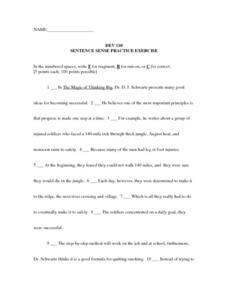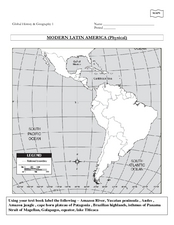National Energy Education Development Project
Exploring Oil and Gas
The United States consumes more oil than any other country, about 1.85 billion barrels (or 77 billion gallons) a day. Viewers learn about the history of fossil fuel exploration and how they are formed in an informative presentation. They...
University of New Mexico
Understanding Motor Planning Deficits in Young Children with Autism Spectrum Disorder
Packet with possibilities, a helpful presentation is designed to provide information about motor planning deficits in learners with autism spectrum disorder. The presentation also models activities that improve planning and develop...
Howard Hughes Medical Institute
Modeling Trophic Cascades
In the ecological game of who eats who, one small change can have a big impact! Individuals create food chains in an array of ecosystems, then determine what happens to organisms in the chain when one organism changes its feeding...
NOAA
Climate Is Our Friend…Isn’t It?: Make an Extinction Polyhedron
Climate affects populations in different ways. Scholars research extinct organisms and mass extinctions in part three of the 10-installment Discover Your Changing World series. They create graphic organizers, then fill in the...
American Museum of Natural History
The Tree of Life
Groups of species can have more in common than meets the eye. An interactive cladogram shows some of the connections between important groups of species. Learners click on sections of the diagram to learn more about the connections or on...
Curated OER
Counting Animals
In this counting to ten worksheet, learners examine a picture of different animals. Students count each of the 7 kinds of animals and record the totals. All totals will be under ten.
Curated OER
HOW ABOUT A T-BONE?
Students investigate the events that created the historical context for the Progressive Era in the United States. They evaluate the conflicts of business and common people of the time. The research is done using primary and secondary...
Curated OER
Habitats
Students examine how different living things interact with their environment. As a class, they discuss the characteristics of a habitat and write the list on the board. In groups, they focus on one habitat and create a mural of the...
Curated OER
Would You Rather?
Break the ice with a series of silly questions. This slide show asks 10 different, would you rather, questions. Each question has three silly answers to choose from. Great for classroom fun, the first day of school, or as a way to take a...
Curated OER
Capitalization of Nouns
Which nouns are capitalized? Challenge young editors with these erroneous sentences, all of which require capitalization. After circling all the necessary capitals in 10 sentences, they rewrite two sentences (which are all in capital...
Sinclair Community College
Sentence Sense Practice Exercise
Test your learners' skills in identifying complete sentences, fragments, and run-ons with a worksheet challenge. Every sentence from multiple paragraphs is under question, and pupils have to decide if each sentence is a...
Compassion in World Farming Trust
Selective Breeding of Farm Animals
Biology learners read about selective breeding in chickens and how it has produced high-yield meat specimens and rapid egg-layers. The unpleasant effects of artificial selection are explored, as well as options to supporting this...
K12 Reader
Figurative Language: What Is It?
"Lucky lady." "Straight as an arrow." Here's a figurative language worksheet that provides middle schoolers with six examples and asks them to identify the literary device modeled.
Curated OER
Manufacture of Ground Beef
Students study the proper temperature and technique to cook ground meat safely. They examine the critical control points when ground beef is being processed.
Curated OER
Indians Are Coming!
Help your class increase their awareness of concepts related to reading and spelling. They identify the digraph /oa/ in spoken language and spelling. After a brief discussion, they read A Toad on the Road, listening for the target sound....
Curated OER
World History Worksheet #8
What customs did the Ancient Aztecs practice? In this world history worksheet, students utilize a word bank of 10 terms or phrases to answer 10 fill in the blank questions pertaining to the Aztec culture. A short answer question at the...
Curated OER
Utah Crossword
In this Utah worksheet, students explore the state of Utah. Students must complete the crossword puzzle by coming up with the answers to the ten clues given.
Curated OER
Famous Animals Quiz 1
In this famous animals worksheet, students answer short answer questions identifying famous animals in books, movies, music, and more. Students complete 10 short answer questions.
Curated OER
Storytime Quiz 1
In this novels instructional activity, students answer short answer questions about famous novels and authors. Students complete 10 short answer questions.
Curated OER
Deciphering Your Cell Phone Bill
You just got your first cell phone bill, but what does it all mean? Clear up the confusion for your young consumers as they break down and itemize a cell phone bill to better understand what they are paying for and why. This type of...
Curated OER
Global History & Geography: Latin America
The instructions say to use a text-book to label 11 different regions in modern Latin America. If a text-book is not available a map can be found on-line and printed for student reference.
Curated OER
India
Take a mental trip to India with your class. But before you go, review some basics about Indian culture. Several facts, a break down of the Indian flag, and a list of words adopted from India are all provided. Tip: Adding rich images...
Curated OER
Animals You Can See at the Zoo
In this zoo animal worksheet, students read facts about different zoo animals then answer questions regarding the different animals.
Curated OER
Amazing Animals of Mexico
Students research the different animals of Mexico. They read an informational handout, discuss the various animals and habitats, and match animals with their habitats on a worksheet.

























